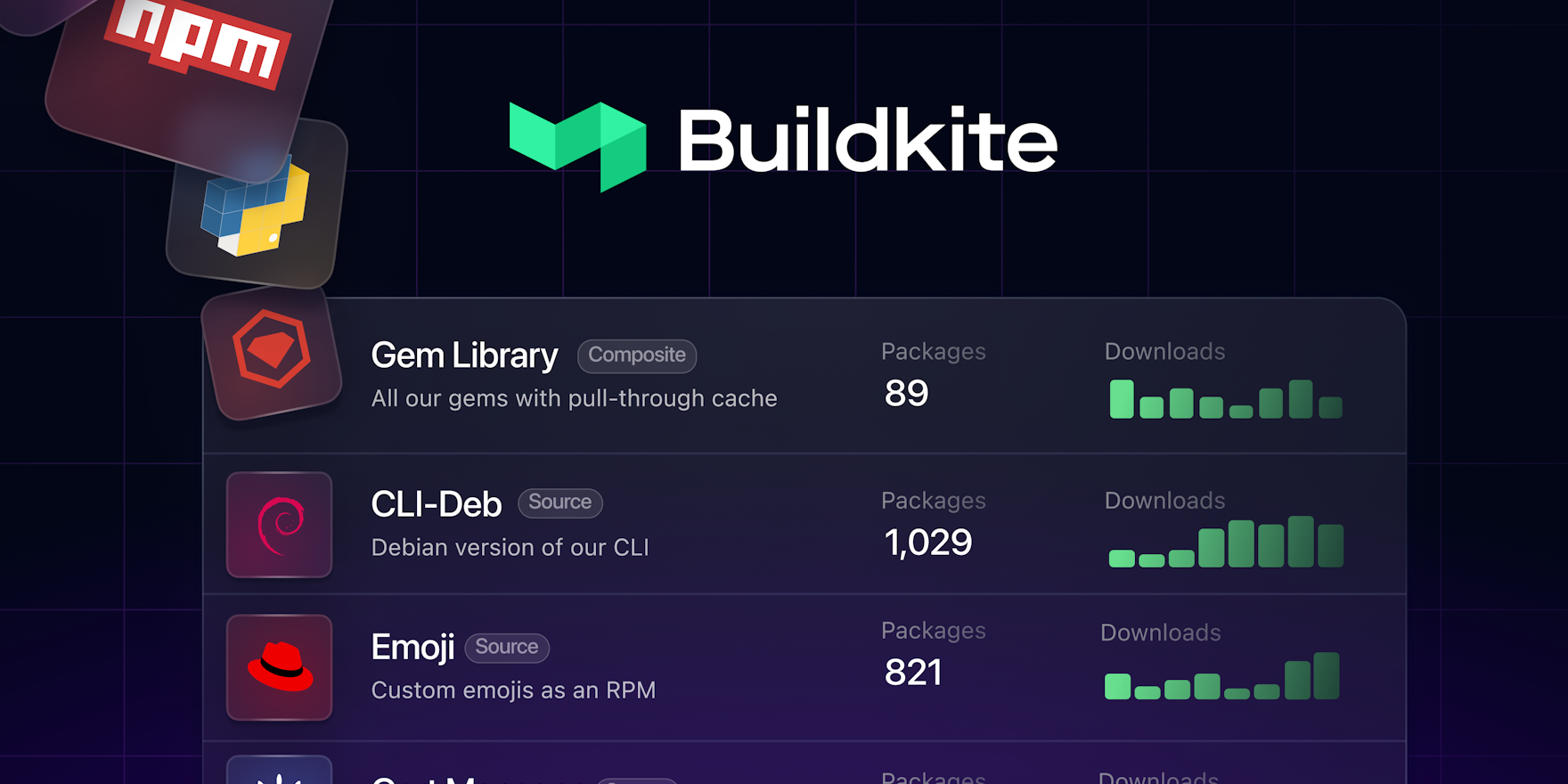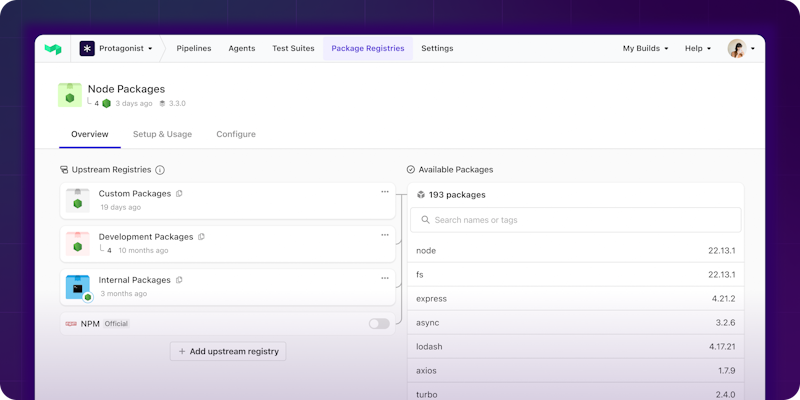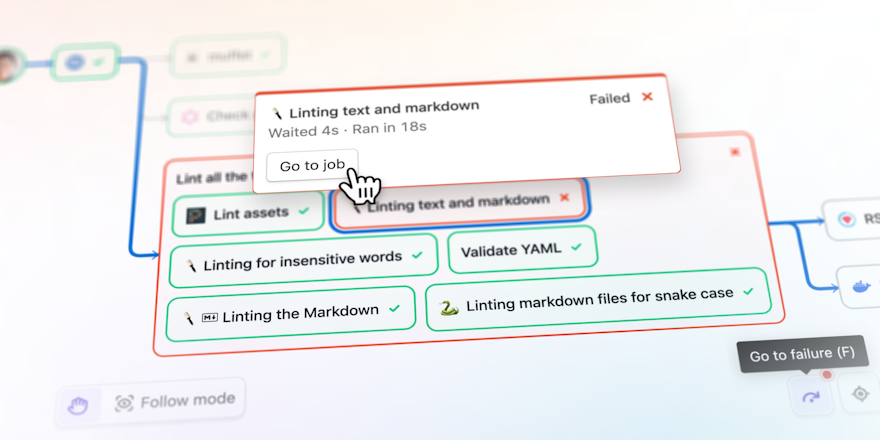
When it comes to choosing a repository manager, you may find yourself comparing between incumbent options and newer solutions, asking questions like:
- Does this tool handle the types of packages we need it to?
- Will it give our team the control and flexibility we need to keep our delivery process humming, even as we grow?
- Will it keep us all productive and happy?
In this guide, we’ll compare JFrog Artifactory to Buildkite Package Registries on each of these points and some others, in hopes of helping you make the right choice for your team.
As one of the oldest and most established repository managers, Artifactory has long been the de facto choice. It’s a solid product, almost endlessly configurable, and for some teams, can be a great fit. Buildkite Package Registries, on the other hand, brings a new perspective that’s focused on speed, developer experience, and reducing the operational burden—which might be just what you’re looking for.
Let’s dive in.
Package types: How much coverage do you really need?
An artifact manager is only as useful as it's able to handle the artifacts you produce. With support for over 30 package types, Artifactory wins hands-down on breadth of coverage; no other repository manager handles as many varieties natively. This is one of Artifactory’s key selling points, in fact, and if you have a highly diverse tech stack, or manage legacy software alongside newer apps, it might make all the difference.
But if you’re not a team that needs every box checked when it comes to package types, you might want to pause and consider the tradeoffs. Deploying and maintaining self-hosted Artifactory can be a complex undertaking, and as we’ll discuss next, it can introduce a significant operational burden to your team. In practice, most teams aren’t targeting 30 different package ecosystems. They’re focused on only a key few—the ones that matter to them and to their customers.
Buildkite Package Registries takes a different approach by providing native support for the most popular package ecosystems—Node.js, Python, Go, Java, .NET, Docker, Ruby, Linux, and many others, with more on the way (see the roadmap for details). The goal is a streamlined product that simplifies the core use cases for most teams, and offers a fallback option for the longer tail with the catch-all Files type.
If you truly need deep support for 30+ package types, then Artifactory might be the better fit for you. But if not, you may find that Buildkite has everything you need—with far less complexity.
Ops: How much infrastructure do you want to manage?
Self-hosted Artifactory gives you complete control over where and how you run the Artifactory service, manage its data, and store your packages. This approach can be attractive to teams that place a high value on total control—and may sometimes be necessary, depending on the situation (e.g., with highly rigid compliance requirements).
But with that control comes a big operational surface area, one that not every team needs or wants. Initial deployments are often relatively simple: a virtual machine, DB instance, some attached storage, and you’re off and running. But as teams grow, and the load on the Artifactory server increases, scaling up (and out) to accommodate that growth often becomes necessary—and can take work, like the following:
- Artifactory ships with an on-board database (Apache Derby), but JFrog advises against using it in production. That means having to bring your own—which requires taking on the responsibility of maintaining (and monitoring, and tuning, etc.) that database over time.
- Running Artifactory in high-availability (HA) mode (e.g., for failover) or geographically distributed configurations can require a significant investment in infrastructure, and with it, human expertise and ongoing support.
- Your team will have to handle operating a production service under load, along with all of the standard issues that can arise as a result: indexing delays, CPU spikes, server crashes, network latencies, cache invalidation, etc. Not to mention having to keep up with Artifactory's frequent patch releases, which can also take time.
All of this is manageable with Artifactory, of course—and many teams do it successfully, either by choice or by necessity, despite the cost.
But we’ve talked to a lot of teams at large engineering organizations that would rather spend this time building and shipping software. They’d prefer their repository managers just worked, scaling with them automatically (without slowing them down) and delivering the right level of control and customization where they need it.
That’s where Buildkite Package Registries comes in. As a standalone component of the Buildkite platform, Package Registries is available in two configurations:
- Fully hosted, in which Buildkite runs the control plane and hosts all of your artifacts for you.
- Hybrid, in which Buildkite runs the control plane, and you host your packages yourself. With this choice, you can store your artifacts in your own cloud’s object storage, as close as possible to your build runners (and within your security perimeter), to keep build times down even as your team continues to scale up.
In both options, the control plane is built on the same massively scalable foundation as the Buildkite platform that powers some of the largest software teams in the world. Maintaining a high-availability production service/database becomes our problem, not yours. Meanwhile, you get:
- Super-fast indexing, such that newly uploaded packages are indexed and available (to your builds and your customers) within seconds.
- Upstream registry mirroring with pull-through caching, so you can go even faster—and with greater stability—by dramatically reducing the impact of public registries as a bottleneck (or point of failure).
It comes down to this: If you need total control over the operationalization of your artifact management service—the servers, database, supporting infrastructure, networking, storage, monitoring, backups, permissions, and all the rest—then Artifactory might be a good fit for you. But if you’d prefer to have control over only what matters (i.e., what helps you ship faster), then you may want to give Buildkite a try.
Developer experience: Does great UX matter? 🤔 ☺️
Most users don’t spend a lot of time clicking around in the UIs of their build tools. But some do. And those who do know how valuable it can be (on many dimensions—productivity included) when those tools are designed and built with humans in mind.
We’ve worked hard to develop a reputation for delivering delightful, productivity-focused experiences that developers love. And while Package Registries is still a fairly new product, it’s inheriting the same features (and design ethos) that Buildkite is well known for:
- Documentation that consistently wins us praise from engineering teams
- A clean, modern UX with thoughtful touches like custom emojis
- A proven track record of continually improving our product and developer experiences—with a publicly documented and updated roadmap.

Buildkite Package Registries
Artifactory’s UI certainly enables you to get the job done, no doubt about it. But if delightful user experiences—and a demonstrated commitment to continuously improving them—rank high on your list of what you value in a product, then you may want to kick the tires for yourself with Buildkite.
Next steps
JFrog Artifactory is the incumbent in the repository management space for a reason: it’s highly configurable, has great support for package types, and works well for many teams. But we think Buildkite Package Registries offers a compelling alternative that delivers the goods most teams are looking for: coverage of the ecosystems they care about most, blazing-fast indexing and overall performance, unlimited scale with zero operational burden, and a delightful user experience.
And there’s a bonus: While Package Registries is designed to work as a standalone product, it’s also an integrated component of the Buildkite Scale-Out Delivery platform. If you’re already on Buildkite Pipelines, for example, you also get:
- Native support for SLSA Build Level 1. Among other foundational security requirements, this means Buildkite generates and maintains cryptographically verifiable SLSA provenance records for your artifacts, ensuring their origins are always traceable.
- Seamless authentication of your build agents with OpenID Connect. Artifacts created during builds can be published directly to your repositories with minimal configuration, and packages can be consumed by subsequent build steps without additional setup.
- And of course, a world-class support team and transparent pricing that won’t ever take you by surprise.
While JFrog Artifactory is still a solid choice, we think that for many teams, there’s a better path. We hope you’ll let us prove that by giving Buildkite a closer look:
- Dive into the Package Registries docs
- Explore what it looks like to migrate from Artifactory
- Get started now, either with a free trial or by scheduling a demo for your team




